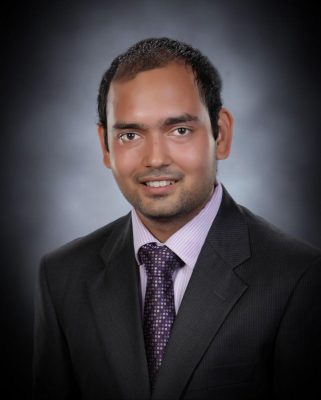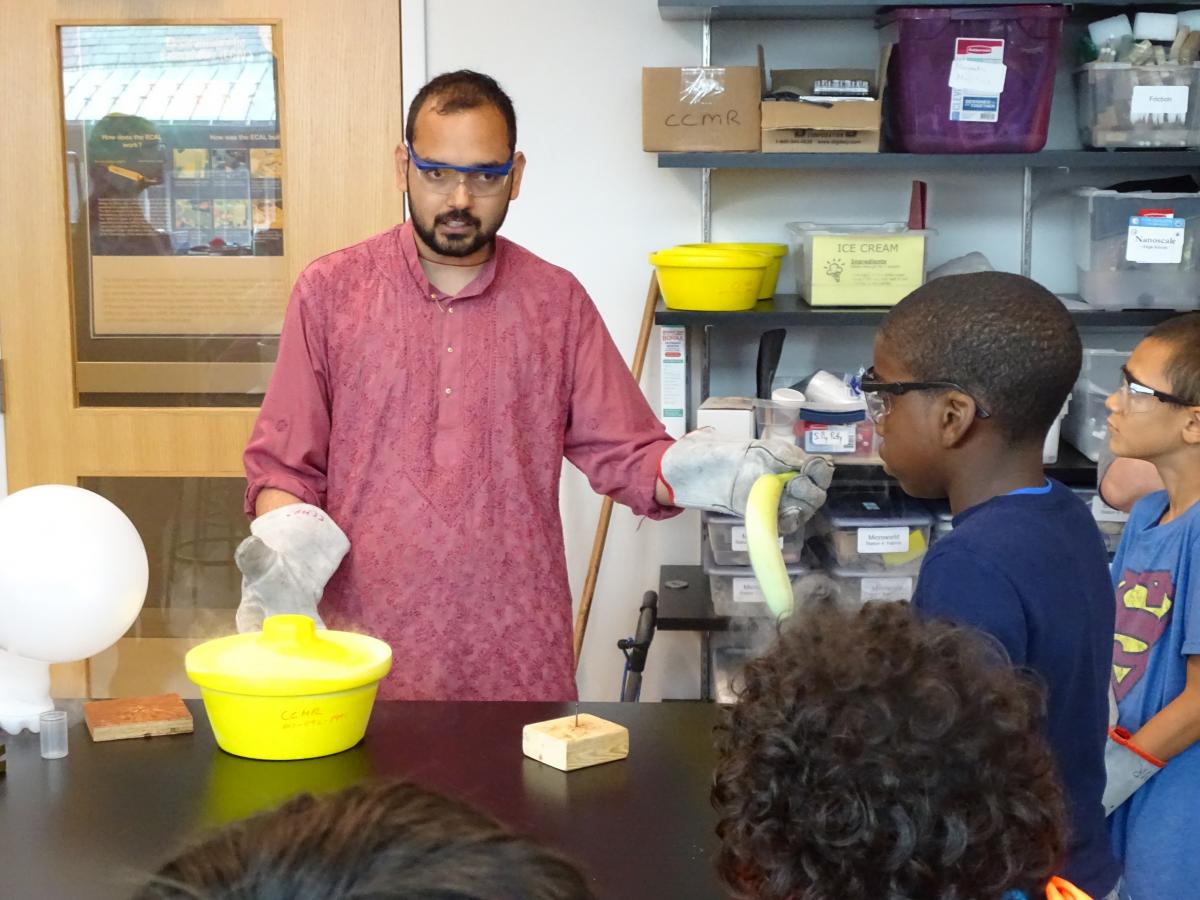Student Spotlight: Madhur Srivastava

What is your area of research?
I am a third year Ph.D. student in the Meinig School of Biomedical Engineering and doing my research at the National Biomedical Center for Advanced ESR Technology (ACERT) at Cornell. My area of research is signal processing in magnetic resonance spectroscopic and imaging techniques such as Electron Spin Resonance (ESR), Nuclear Magnetic Resonance (NMR) and Magnetic Resonance Imaging (MRI). I am currently developing novel signal de-noising methods, based on “wavelet transforms” to enhance signal accuracy and to reduce signal acquisition times for magnetic resonance signals.
What inspired you to choose this field of study?
Fields with applications to human diseases and health have always interested me. Magnetic resonance spectroscopy and imaging provided me the opportunity to apply my knowledge of signal processing to understand, diagnose, and combat diseases.
Why is this research important?
Magnetic resonance techniques are heavily relied on to study living systems and are widely used in both laboratory and clinical settings. Noise is a major problem in interpreting signals for diagnosing disease, understanding disease mechanisms, and developing drugs.
For laboratory techniques such as ESR and NMR, my research will allow studies of biomolecules with low concentrations, prevent sample degradation due to long acquisition times, save several hours of experimental time, and significantly reduce the cost of instrumentation purchase and maintenance. For clinical imaging techniques like MRI, it will improve patient diagnosis and comfort, and permit MRI scans in emergency cases requiring reduced acquisition times. Imagine obtaining a noise-free MRI scan in 15 minutes instead of 50 minutes, without needing a new machine.
Signal processing methods are simple and easy to apply. My research would be useful in both laboratory and clinical settings. In addition, this research can easily be extended to other clinical as well as laboratory imaging and spectroscopy techniques.
How has your background influenced your scholarship?
I come from a place where first you do engineering and then decide what you want to do in life! Born into a family of engineers, it was a natural path to follow. Pursuing engineering helped me learn problem-solving skills needed for limited-time situations. Majoring in electrical engineering further introduced me to diverse disciplines both within and outside engineering, as electrical engineering is applied almost everywhere. Moreover, I learned to work as a part of a team. One thing I learned as an engineer is that perfect should not be the enemy of good. This all became useful in my current research. As a Ph.D. student in biomedical engineering, I work with people from different academic backgrounds to solve common research problems. In my lab I work with chemists, biologists, physicists, clinicians, doctors, and computer scientists, which greatly contributes to the overall quality of my research.
What else has influenced your thinking as a researcher or scholar?
I have been lucky to have great mentors in my life from whom I sought both inspiration and guidance. My father, Dr. Rajendra Srivastava, pursued his Ph.D. in his early 50s. His determination and perseverance inspired me to pursue my research interests. I learned from my undergraduate physics professor, Dr. Rajneesh Atre, to enjoy research and to work selflessly. My undergraduate supervisor, Prof. Satish Singh, trained and prepared me for graduate school. Prof. Prasanta Panigrahi, under whom I did a summer internship, cultivated in me scientific curiosity and openness toward new ideas. My M.Eng. supervisor, Prof. Sheila Hemami, taught me critical thinking, and how to efficiently and sensibly conduct research. My Ph.D. committee members, Prof. C. Lindsay Anderson and Prof. Gerald Feigenson, provide constant support and feedback on my research. Through them, I have learned how to ask important questions about my research, both from within a specific field and a general point of view. My Ph.D. advisor and committee chair, Prof. Jack Freed, is a constant source of motivation for me. He brings out the best in me. I have learned from him how to convert abstract ideas into useful and meaningful research. Conversations with him are so enriching and informative that I come up with new ideas regularly, and love to do research.
 The friendly, collaborative, and fun environment that I share with my lab members has also enhanced my research capabilities. Exchange of ideas and lively academic conversations outside lab with my friends Siddarth Chandsekaran, Amandeep Gupta, Ravi Kumar, Aritro Sinharoy, Aadhar Jain, Munir Ahmad Nayak, and Poornima Padmanabhan have greatly enhanced my scholarship.
The friendly, collaborative, and fun environment that I share with my lab members has also enhanced my research capabilities. Exchange of ideas and lively academic conversations outside lab with my friends Siddarth Chandsekaran, Amandeep Gupta, Ravi Kumar, Aritro Sinharoy, Aadhar Jain, Munir Ahmad Nayak, and Poornima Padmanabhan have greatly enhanced my scholarship.
Because of Cornell, I am fortunate to have flatmates like Tayler Eaton, Abby Yip, Enoch Kwon, and Mate Rigo, who come from different countries, cultures, and academic backgrounds. They influenced me to think not just in terms of science and engineering, but also in terms of history, society, and community as a whole.
Through the Cornell Center for Materials Research’s (CCMR) outreach program, I have learned to communicate my research effectively by teaching science to K-12 school students. My department’s summer immersion program, in which I spent a summer at Weill Cornell Medical College, made me aware of various health care issues. It was important in focusing my research towards those issues. My diverse coursework enabled me to think about a problem from the perspective of different disciplines.
You’re one of six doctoral students to receive a Commercialization Fellowship under the College of Engineering. Congratulations! Can you tell me a little bit about the technology you’ll be developing during this fellowship?
I developed a new signal processing method/process to de-noise experimental signals using “wavelet transforms.” The current state-of-the-art signal de-noising methods are not very effective for experimental signals. Unlike natural images and other types of signals, experimental signals in biological and biomedical applications are less tolerant of signal distortion and inadequate de-noising caused by standard methods. The new method is able to reduce signal acquisition times by more than an order of magnitude and accurately retrieves the signal. Through this fellowship, I will be looking into commercial aspects of the new de-noising method.
What are you most looking forward to about the fellowship?
The Ph.D. Commercialization Fellowship Program provides me the perfect platform to develop the new method into a successful commercialized product. I want to use this opportunity to learn and implement different aspects of commercialization, including developing business plans. Through this program, I also want to gain insights about various potential markets for the innovation, and find the best way to commercialize it. I will use all the necessary resources, training, and expertise provided in the program to work on the business side of the innovation. I will be involved in each and every aspect required to commercialize the innovation in a time-limited and result-oriented manner. I hope to introduce and market the innovation soon after the end of the fellowship.
In what ways will the work you do during this fellowship improve or expand your scholarship?
Although I will be working on the commercial aspects of my research innovation, the overall training provided during the fellowship will expand my knowledge of the business side of technology development. I will learn about market search, supply chains, intellectual property, customer development, fundraising, business plans, and all the other general principles required to commercialize a product. I will also learn about different stakeholders. Further, I will greatly benefit from hands-on experience in business skill development and entrepreneurial culture. This, along with my research experience, will give me the comprehensive education needed to succeed in the field of technology.
Why did you choose Cornell to pursue your degree?
I wanted to live and do research in a diverse environment, both academically and culturally. Apart from being an elite university, Cornell is an ocean of knowledge and opportunity. Cornell offered a unique mix of breadth and depth of disciplines. I can take any course of my liking, and attend a seminar/workshop on any subject. I was really driven by the “any person, any study” motto.
What’s next for you?
I am still figuring it out. There are many careers paths that I can choose from such as academia, entrepreneurship and intellectual property law, or a combination of them. However, one thing that is certain is that whatever I do next, it will be related to technology.
Any advice for incoming graduate students?
Explore. While finding a research group, look for the right fit in terms of your broad research interests and academic philosophy. You should enjoy your research and working with your advisor and lab members. Meet your Ph.D. committee members regularly, and seek their feedback and opinions.
At Cornell there are a lot of programs, workshops, and resources that assist graduate students to succeed in their studies and career planning. Take advantage of them.
Get involved with the student organizations of your liking and contribute to their goals. Take benefit from Cornell’s academic and cultural diversity. Socialize and network with your fellow students and faculty.
The knowledge and skills acquired in the graduate program can be very useful in non-academic careers. If you are looking for a career outside academia, the Cornell BEST (Broadening Experiences in Scientific Training) program, in particular, helps identify and explore non-academic careers after graduation.
And lastly, don’t forget to explore and cherish Cornell, Ithaca, and nearby locations. By the time you graduate, you may be surprised by how many amazing places there are, of which you were never aware.
Interview by Sally Kral, communications and outreach assistant in the Graduate School
